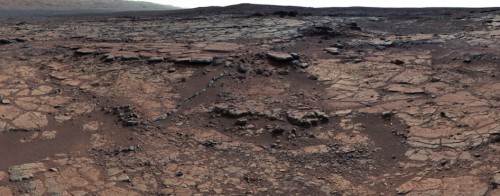
There is a report about Mars which has been getting a lot of attention the past few weeks (in addition to the methane and organics found): that the Curiosity rover may have found evidence for ancient microbial life itself. Specifically, microbial mats, which are common on Earth; the report comes from noted geobiologist Nora Noffke, who has been studying images sent back by the rover since it landed in 2012.
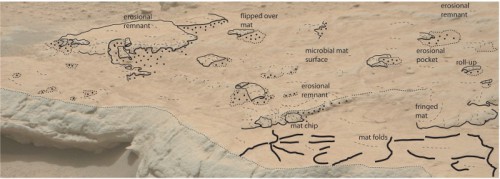
Noffke now suggests that some of the images, taken earlier back at Yellowknife Bay, specifically at Gillespie Lake Member, show small-scale patterns which are consistent with microbial mats on Earth. Her detailed 24-page article in the journal Astrobiology covers these with a study of about a dozen images. She makes a compelling case, given her background experience as a leading geobiologist, current faculty member at Old Dominion University, a professor at Ocean, Earth & Atmospheric Sciences, and a research fellow at the Carnegie Institution.
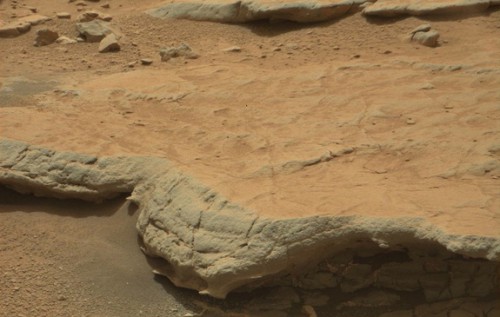
She does stress that more imaging and other analysis needs to be done, of course. She acknowledges that there may be another explanation for the features, but she is confident that they merit closer inspection. The possibility is also strengthened by the other recent news from the Curiosity team that Gale crater did indeed used to be a playa lake fed by streams millions or billions of years ago—ideal conditions for microbial mats on Earth.
Curiosity has since traveled far from this location, but there are plenty of other good areas ahead, including some interesting rock textures and other features where it is located right now at Pahrump Hills.
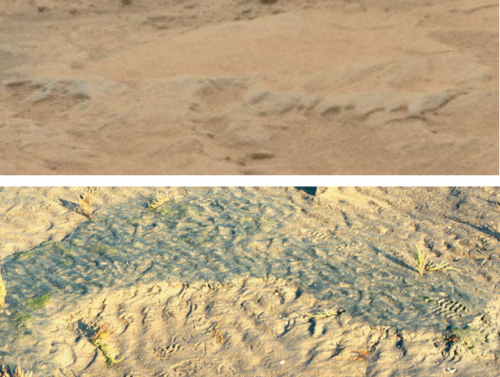
In a new Space.com article (Jan. 9), it was reported that the Curiosity team is doubtful of the biological interpretation, and that the sandstone features are most likely just caused by erosion. As Curiosity project scientist Ashwin Vasavada stated, “We really didn’t see anything that can’t be explained by natural processes of transporting that sand in water, and the nature of the rocks suggested that it was just a fluvial sandstone.” He added: “We do have several members of our team who are always keen to look out for things that might be caused by biological processes, but there was no reason, we felt, to explore that [option] at that site. It came down to nothing exceptional, from our point of view, that wasn’t just a consequence of erosion of this sandstone.”
The team did, however, drill and analyze the mudstone in the Sheepbed unit just below Gillespie Lake Member, and found more evidence that this area used to be underwater in a lake and the first definitive detection of organics.
It should be noted, however, that Noffke told AmericaSpace today that she does not know if any of the Curiosity team has read the paper itself yet, and that specific arguments she made have not been addressed by the Curiosity team or in the Space.com article. She also stated that the Space.com writer had not contacted her about the report.
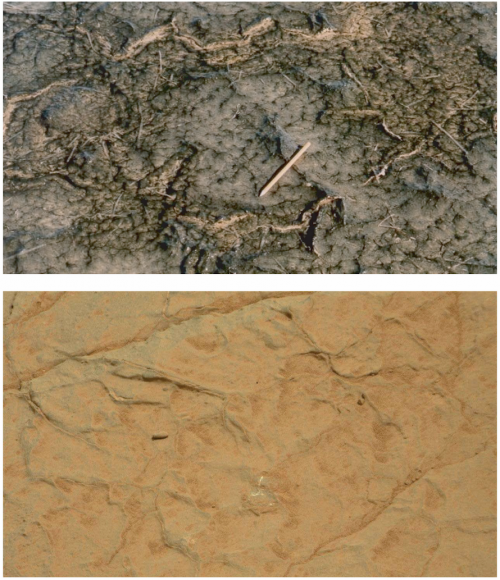
It would be interesting and beneficial to hear a more detailed response from the Curiosity team, given the level of detail in Noffke’s paper.
Earlier, respected astrobiologist and planetary scientist Chris McKay had this to say: “I’ve seen many papers that say ‘Look, here’s a pile of dirt on Mars, and here’s a pile of dirt on Earth. And because they look the same, the same mechanism must have made each pile on the two planets.”
He added: “That’s an easy argument to make, and it’s typically not very convincing. However, Noffke’s paper is the most carefully done analysis of the sort that I’ve seen, which is why it’s the first of its kind published in Astrobiology.”
Another geomicrobiologist, Penelope Boston, had said, “Along with the recent reports of methane and organics on Mars, her findings add an intriguing piece to the puzzle of a possible history for life on our neighboring planet.”
Noffke herself is very open about it still being a hypothesis, but contends it is one that deserves to be followed up on: “All I can say is, here’s my hypothesis and here’s all the evidence that I have, although I do think that this evidence is a lot.”
The Curiosity team might be right, but Curiosity was never meant to be a search-for-life mission to begin with, but rather a geology-focused mission, looking for evidence of past habitability, but not of life itself. That said, it is still possible that it (or any rover) could come across just such evidence in its travels. Validating such a discovery, however, might not be possible with Curiosity alone (unless there were clear, unambiguous fossils, for example); follow-up would likely need to be dome by future missions and/or sample-returns.
The debate over these findings will likely continue for some time to come, especially if similar features are seen again later on.
The paper, with many more images, is here (PDF), and there is also a good, new podcast interview with Noffke here.
Want to keep up-to-date with all things space? Be sure to “Like” AmericaSpace on Facebook and follow us on Twitter: @AmericaSpace




Outstanding work!
Curiosity? perhaps. But Opportunity, too. Not only morphology, but with statiscal analysis on morphometrical measures, comparing Earth/Mars: microbialites on Meridiani planum:
see International Journal of Aeronautical and Space Sciences: http://ijass.org/PublishedPaper/year_abstract.asp?idx=474
Our Mars landers, from Viking to Curiosity, are absolutely one of the very best investments of taxpayer dollars that we have ever made. Teabaggers be damned, if raising my taxes will increase the amount of funding received by NASA from 0.48 of a penny of each federal budget dollar to a whole penny, then I’d be DELIGHTED to pay it if it would lead to a habitat on Mars staffed by geobiologists such as Dr. Nora Noffke. EXCELLENT, EXCITING WORK! Very promising! I’m eagerly looking forward to hearing more!
Thanks for that link, Giorgio, I hadn’t seen that paper yet…